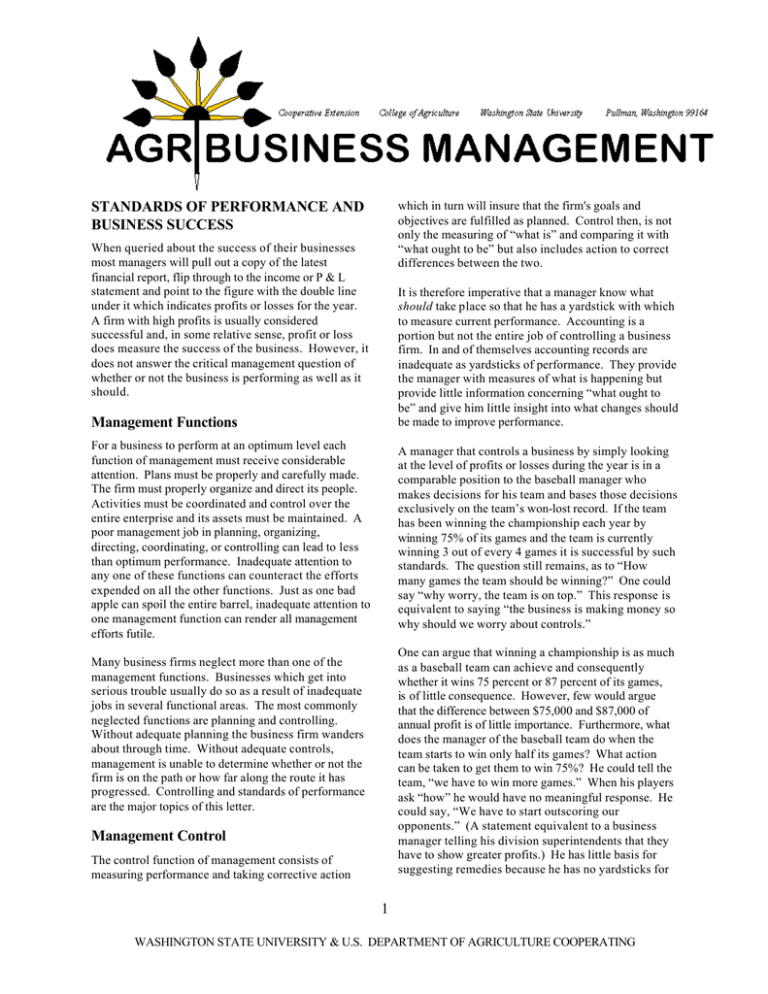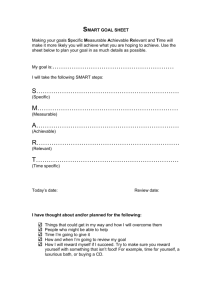STANDARDS OF PERFORMANCE AND
advertisement

STANDARDS OF PERFORMANCE AND BUSINESS SUCCESS which in turn will insure that the firm's goals and objectives are fulfilled as planned. Control then, is not only the measuring of “what is” and comparing it with “what ought to be” but also includes action to correct differences between the two. When queried about the success of their businesses most managers will pull out a copy of the latest financial report, flip through to the income or P & L statement and point to the figure with the double line under it which indicates profits or losses for the year. A firm with high profits is usually considered successful and, in some relative sense, profit or loss does measure the success of the business. However, it does not answer the critical management question of whether or not the business is performing as well as it should. It is therefore imperative that a manager know what should take place so that he has a yardstick with which to measure current performance. Accounting is a portion but not the entire job of controlling a business firm. In and of themselves accounting records are inadequate as yardsticks of performance. They provide the manager with measures of what is happening but provide little information concerning “what ought to be” and give him little insight into what changes should be made to improve performance. Management Functions For a business to perform at an optimum level each function of management must receive considerable attention. Plans must be properly and carefully made. The firm must properly organize and direct its people. Activities must be coordinated and control over the entire enterprise and its assets must be maintained. A poor management job in planning, organizing, directing, coordinating, or controlling can lead to less than optimum performance. Inadequate attention to any one of these functions can counteract the efforts expended on all the other functions. Just as one bad apple can spoil the entire barrel, inadequate attention to one management function can render all management efforts futile. A manager that controls a business by simply looking at the level of profits or losses during the year is in a comparable position to the baseball manager who makes decisions for his team and bases those decisions exclusively on the team’s won-lost record. If the team has been winning the championship each year by winning 75% of its games and the team is currently winning 3 out of every 4 games it is successful by such standards. The question still remains, as to “How many games the team should be winning?” One could say “why worry, the team is on top.” This response is equivalent to saying “the business is making money so why should we worry about controls.” One can argue that winning a championship is as much as a baseball team can achieve and consequently whether it wins 75 percent or 87 percent of its games, is of little consequence. However, few would argue that the difference between $75,000 and $87,000 of annual profit is of little importance. Furthermore, what does the manager of the baseball team do when the team starts to win only half its games? What action can be taken to get them to win 75%? He could tell the team, “we have to win more games.” When his players ask “how” he would have no meaningful response. He could say, “We have to start outscoring our opponents.” (A statement equivalent to a business manager telling his division superintendents that they have to show greater profits.) He has little basis for suggesting remedies because he has no yardsticks for Many business firms neglect more than one of the management functions. Businesses which get into serious trouble usually do so as a result of inadequate jobs in several functional areas. The most commonly neglected functions are planning and controlling. Without adequate planning the business firm wanders about through time. Without adequate controls, management is unable to determine whether or not the firm is on the path or how far along the route it has progressed. Controlling and standards of performance are the major topics of this letter. Management Control The control function of management consists of measuring performance and taking corrective action 1 WASHINGTON STATE UNIVERSITY & U.S. DEPARTMENT OF AGRICULTURE COOPERATING measuring performance. He doesn’t know whether hitting, fielding, or pitching are at the bottom of the problem. He doesn't know where to start corrective action. Furthermore, he might think it is bad fielding when in fact it may be poor pitching or a combination of the two. 9. 10. 11. 12. 13. This list is presented only as an example and would probably not fit the needs of any particular business and would not be a complete list if it did. In developing this list of factors, management defines those areas of the business where poor performance can seriously affect profits. At the same time the types of yardsticks that might be useful in measuring current performance are suggested. With proper controls and proper yardsticks to measure the various elements of performance, our baseball manager would be in a much better position to rectify the problem and get the team back on the winning track. He would analyze each team member’s current performance (batting average, fielding average, earned run average, etc.) in the light of what that team member is capable of. Then he could coach those whose performance had deteriorated and thus alleviate the problem. The second step involves finer definition of control areas and the determination of appropriate measures of performance for those areas. This can be done by going down the list and combining those items which appear to be related or those which are duplications. At the same time those items which are not controllable should be removed from the list. Thus, in our illustration, in-plant labor productivity (1), number of men required per working shift (11) and overtime per week (12) might be combined into weekly plant labor productivity and plant labor costs. Real estate taxes and wage rates are probably determined outside the business enterprise and hence are not controllable by it. Therefore, these items should be removed from the list. Whether a man manages a baseball team or a business enterprise he must measure what is happening and compare it with what should be happening if he is going to maintain control and improve performance. Development of Proper Controls The two biggest problems which managers face when developing controls for their organizations are: 1. Determination of appropriate performance areas or control units and 2. Determination of what constitutes a satisfactory level of performance (“What ought to be”) within each area or unit. Now it is possible to develop types of yardsticks which will be useful in comparing “what is” with “what ought to be.” What measures would be appropriate to determine the level of performance for the area that we have defined as being important to the success of the business (weekly plant labor productivity and plant labor costs)? Output per man-hour, labor cost per unit of output, and overtime hours per week are measures of performance in this performance or control area. They are measures which can be taken each week to determine the level of current performance yet they measure “what is” and still give little insight concerning “what ought to be.” These two problems are not separate and distinct but rather are interwoven so that the manager must solve them simultaneously. In the process of solving these two problems it usually is advisable to proceed through a series of steps. A good starting point involves sitting down with members of the management team and listing all factors which may have an effect on the profits of the business. It is generally a good policy to make an exhaustive list even at the risk of some duplication. Arguing over the importance (or relevance) of each factor should be avoided until the list is comp lete. This same process should be followed for each performance area on the list. Each performance area should be further defined and appropriate measures of performance developed for it. Such a list might include: 1. 2. 3. 4. 5. 6. 7. 8. Unit sales costs Maintenance and repair costs Number of men required per working shift Overtime per week Etc. Labor productivity (in plant) Labor productivity (sales) Inventory costs Wage rates Losses on Accounts Receivable Real estate taxes Equipment rentals Unit processing costs The third step in the process of developing adequate controls for a business is to determine a satisfactory level of performance for each performance or control area. A simple measure of performance does not provide management with a basis for comparison. For example, if 500 units of product are turned out for each hour of plant labor used, the labor cost per unit of 2 output is 6 cents and the firm incurs 24 hours of overtime per week, management still doesn’t know whether this is good or bad. Of course, if these kinds of measurements are taken over time, management can determine whether current performance is better than, poorer than, or equal to past performance. Such a comparison gives the manager some basis for control since he can ask the superintendent of that department “why the change?” However, if performance were continually poor the manager would observe no change and might assume that the department is doing well. engineering approach. Measures of current performance are gathered and the manager together with the individual(s) responsible for the performance area(s) (in our example the plant superintendent) sit down and discuss levels of performance. The manager asks how performance in this control area can be improved and by how much. In these discussions with the responsible people of various performance areas the manager gains some appreciation of the need for improved performance in other areas. For example, if the plant superintendent says, “Output per man hour and costs per unit would have been better this week if we hadn’t had that three-hour shut down on Tuesday due to machine breakdown. The men were all there doing nothing but getting paid and it sure made performance look bad. I can’t be expected to improve plant performance unless those people over in engineering and maintenance do a better job of taking care of our equipment.” One should be wary of using past performance records as standards for measuring the adequacy of present performance. For instance, if a labor-saving machine is introduced into a plant and past labor productivity measurements are used as standards, a manager might feel that performance is very good (better than the standard) when in fact it could be quite poor. A Key Point The manager can then help the superintendent figure out how better performance could be attained if such problems didn’t occur. In addition and more importantly he should ask what the plant superintendent can do in his own department to improve performance. The result is an achievable standard for this performance area. Of course, the level of performance in any area may be dependent upon levels in other areas of the business. Consequently, this manager must work with the superintendent of engineering and maintenance to develop suitable standards of performance for that department. In this manner, over a period of time, achievable standards are developed. Standards of performance should be developed which reflect what is achievable, not what has been done in the past. That which is achievable is the “what ought to be” that management should use to evaluate current performance. Most managers are at a complete loss when faced with the problem of developing achievable standards. They rely on rules of thumb which generally reflect what was achievable in the past but probably are poor measures of the level of performance currently achievable. There are at least two approaches to the development of achievable standards. One is the Economic Engineering or Building Block approach and the other is the Challenging of Current Performance approach. Each has merit. Caution in the Development of Standards Standards of performance should be developed for all important performance areas. An important performance area is one in which poor performance would have a significant effect on profits. Paper clips used per secretary per working day would not be an important performance area. In this case the cost of measuring current performance would exceed any potential gains. Development of Achievable Performance Standards With the economic engineering or building block method, management people sit down and budget the firm’s input requirements for each job. The process is quite similar to determining the quantities and types of ingredients needed for a cake. In this way they determine such things as how many men are required and how many hours each must work if everything works properly. These requirements then become “Ideal” standards of performance. These in turn are modified to reflect “achievable” standards of performance since seldom do all things work perfectly. Established standards should be reviewed periodically to insure that they are achievable and reflect a high level of currently achievable performance. Use of Standards in the Control Function Once key performance or control areas have been developed, measures of performance defined, and standards established, the manager’s job is essentially one of keeping an administrative eye on things and The second method of developing standards will ultimately lead to the same standards as the economic 3 Summary solving the problems causing poor performance before the situation gets out of hand. Managers cannot expect their businesses to perform as well as they should unless they know “what is happening” as well as what “should be happening.” “What should be” is a standard of performance. Managers would like to have current operations attain high levels of performance. Standards can be developed through a budgeting process (Economic Engineering or Building Block method) or through trial and error (challenging current performance). Discrepancies between actual and desired performance (standards) are warning signs that something is amiss. Corrections should be made with and through people and a man should never be expected to correct poor performance when the situation creating it is under someone else’s control. He should receive periodic reports of actual performance from his subordinates. These he compares with the established standards. Seldom will all performance areas measure up to the standards. Usually there will be several areas which are not quite up to desired levels. Management’s dilemma then is one of deciding which area should receive his attention first, realizing at all times the interrelationships of the various areas. Management by Exception Principal This principal states that management should give its first attention to that problem which if allowed to continue would have the greatest adverse affect on the business. Once this problem is corrected, management can then devote its attention to the next most crucial problem. This rather simple concept is useful to managers when setting priorities for the many things they must do. Thomas A. Brewer Extension Marketing Specialist Making “What is” Conform to “What Ought to be” Serious deficiencies in performance must be corrected if the business is going to do as well as it should. A manager who has gone only as far as finding the problem has done half the job. He has seen the red flag waving. Now he must find the cause and help correct it. Too many managers look at reports, see inadequate levels of performance, and call the supervisor in that department to tell him to get it straightened out. This is seldom satisfactory. Instead the manager should discuss the matter with the person responsible and get to the root of the problem. It may be externally caused as in the case of improper maintenance. He should encourage the supervisor to think of possible remedies which are under his control and help him develop and choose among alternatives. Together they should decide on a plan of action which the supervisor should carry out. 4


